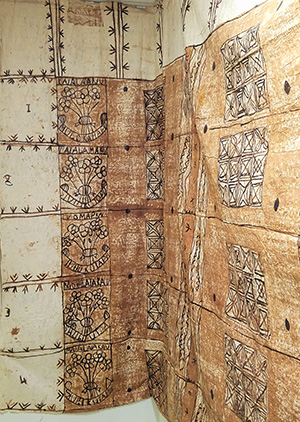Tongan Barkcloth
 Barkcloth from the Pacific island nation of Tonga, which is known tapa, is made of the pounded inner bark of the Paper Mulberry tree. Raw material is taken from young trees, dried and soaked, and then beaten with a wooden mallet called an ike. Women flatten the bark and spread it thinly to make sheets, which are then combined to make cloth.
Barkcloth from the Pacific island nation of Tonga, which is known tapa, is made of the pounded inner bark of the Paper Mulberry tree. Raw material is taken from young trees, dried and soaked, and then beaten with a wooden mallet called an ike. Women flatten the bark and spread it thinly to make sheets, which are then combined to make cloth.
Decorations are added once the cloth is dried. The underlying light reddish-brown designs are embossed using woodblocks. The darker designs are then painted on top. Based on the construction and design, this cloth was likely made in the 1920s or 1930s. The identifiable words on this tapa represent place names, indicating that it may have been made for a special community event of some kind. The numbers on the side of the cloth are used as markers of length. At approximately 9 ft. by 13 ft., this example is only a portion of a much larger piece. Tongan women regularly produce tapa that are more than 50 or 60 feet long.
Traditionally, tapa were used as clothing and blankets, among other uses. Today, its most important use is as a constantly circulating gift. All families have a number of cloths that are kept to be exchanged at funerals especially, but also other important life events such as weddings and first birthdays. The receiving families then redistribute them to other guests, so each cloth has a history from the families that it has passed through.
This Tongan barkcloth is currently on display in the stairwell between the Museum and Anthropology Department offices. Learn more about barkcloth with this Cultures Up Close activity.

